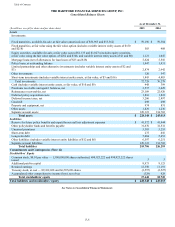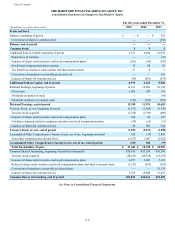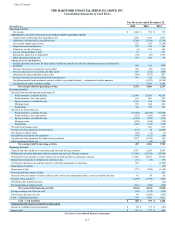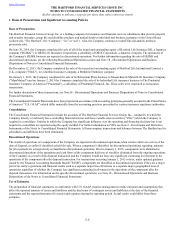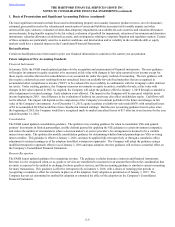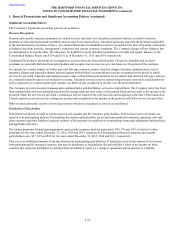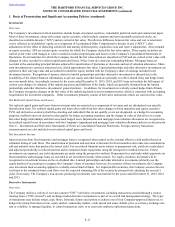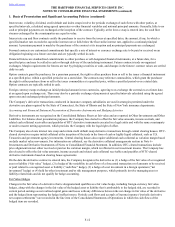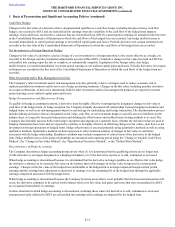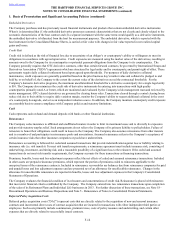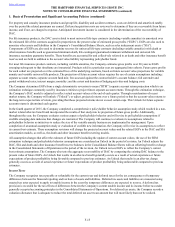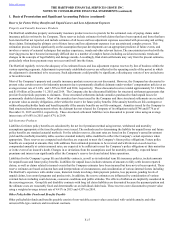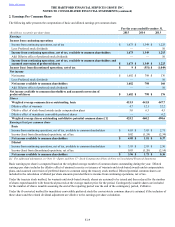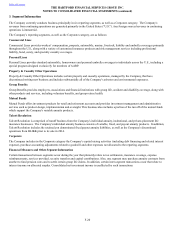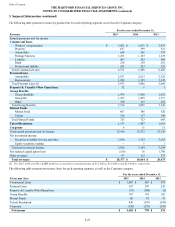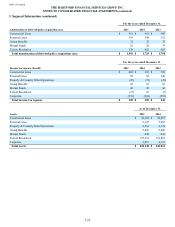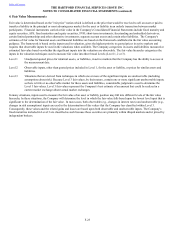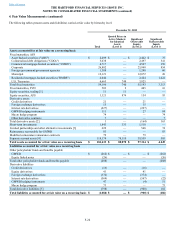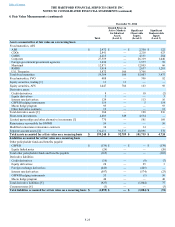The Hartford 2015 Annual Report Download - page 146
Download and view the complete annual report
Please find page 146 of the 2015 The Hartford annual report below. You can navigate through the pages in the report by either clicking on the pages listed below, or by using the keyword search tool below to find specific information within the annual report.
Table of Contents THE HARTFORD FINANCIAL SERVICES GROUP, INC.
NOTES TO CONSOLIDATED FINANCIAL STATEMENTS (continued)
1. Basis of Presentation and Significant Accounting Policies (continued)
F-15
For property and casualty insurance products and group life, disability and accident contracts, costs are deferred and amortized ratably
over the period the related premiums are earned. Deferred acquisition costs are reviewed to determine if they are recoverable from future
income, and if not, are charged to expense. Anticipated investment income is considered in the determination of the recoverability of
DAC.
For life insurance products, the DAC asset related to most universal life-type contracts (including variable annuities) is amortized over
the estimated life of the contracts acquired in proportion to the present value of estimated gross profits (“EGPs”). EGPs are also used to
amortize other assets and liabilities in the Company’s Consolidated Balance Sheets, such as sales inducement assets (“SIA”).
Components of EGPs are also used to determine reserves for universal life-type contracts (including variable annuities) with death or
other insurance benefits such as guaranteed minimum death, life-contingent guaranteed minimum withdrawal and universal life
insurance secondary guarantee benefits. These benefits are accounted for and collectively referred to as death and other insurance benefit
reserves and are held in addition to the account value liability representing policyholder funds.
For most life insurance product contracts, including variable annuities, the Company estimates gross profits over 20 years as EGPs
emerging subsequent to that timeframe are immaterial. Products sold in a particular year are aggregated into cohorts. Future gross profits
for each cohort are projected over the estimated lives of the underlying contracts, based on future account value projections for variable
annuity and variable universal life products. The projection of future account values requires the use of certain assumptions including:
separate account returns; separate account fund mix; fees assessed against the contract holder’s account balance; full surrender and
partial withdrawal rates; interest margin; mortality; and the extent and duration of hedging activities and hedging costs.
The Company determines EGPs from a single deterministic reversion to mean (“RTM”) separate account return projection which is an
estimation technique commonly used by insurance entities to project future separate account returns. Through this estimation technique,
the Company’s DAC model is adjusted to reflect actual account values at the end of each quarter. Through consideration of recent
market returns, the Company will unlock ("Unlock"), or adjust, projected returns over a future period so that the account value returns to
the long-term expected rate of return, providing that those projected returns do not exceed certain caps. This Unlock for future separate
account returns is determined each quarter.
In the fourth quarter of 2015, the Company completed a comprehensive policyholder behavior assumption study which resulted in a non-
market related after-tax benefit and incorporated the results of that study into its projection of future gross profits. Additionally,
throughout the year, the Company evaluates various aspects of policyholder behavior and will revise its policyholder assumptions if
credible emerging data indicates that changes are warranted. The Company will continue to evaluate its assumptions related to
policyholder behavior as initiatives to reduce the size of the variable annuity business are implemented by management. Upon
completion of an annual assumption study or evaluation of credible new information, the Company will revise its assumptions to reflect
its current best estimate. These assumption revisions will change the projected account values and the related EGPs in the DAC and SIA
amortization models, as well as, the death and other insurance benefit reserving models.
All assumption changes that affect the estimate of future EGPs including the update of current account values, the use of the RTM
estimation technique and policyholder behavior assumptions are considered an Unlock in the period of revision. An Unlock adjusts the
DAC, SIA and death and other insurance benefit reserve balances in the Consolidated Balance Sheets with an offsetting benefit or charge
in the Consolidated Statements of Operations in the period of the revision. An Unlock revises EGPs to reflect the Company’ s current
best estimate assumptions. The Company also tests the aggregate recoverability of DAC by comparing the existing DAC balance to the
present value of future EGPs. An Unlock that results in an after-tax benefit generally occurs as a result of actual experience or future
expectations of product profitability being favorable compared to previous estimates. An Unlock that results in an after-tax charge
generally occurs as a result of actual experience or future expectations of product profitability being unfavorable compared to previous
estimates.
Income Taxes
The Company recognizes taxes payable or refundable for the current year and deferred taxes for the tax consequences of temporary
differences between the financial reporting and tax basis of assets and liabilities. Deferred tax assets and liabilities are measured using
enacted tax rates expected to apply to taxable income in the years the temporary differences are expected to reverse. A deferred tax
provision is recorded for the tax effects of differences between the Company's current taxable income and its income before tax under
generally accepted accounting principles in the Consolidated Statements of Operations. For deferred tax assets, the Company records a
valuation allowance that is adequate to reduce the total deferred tax asset to an amount that will more likely than not be realized.


